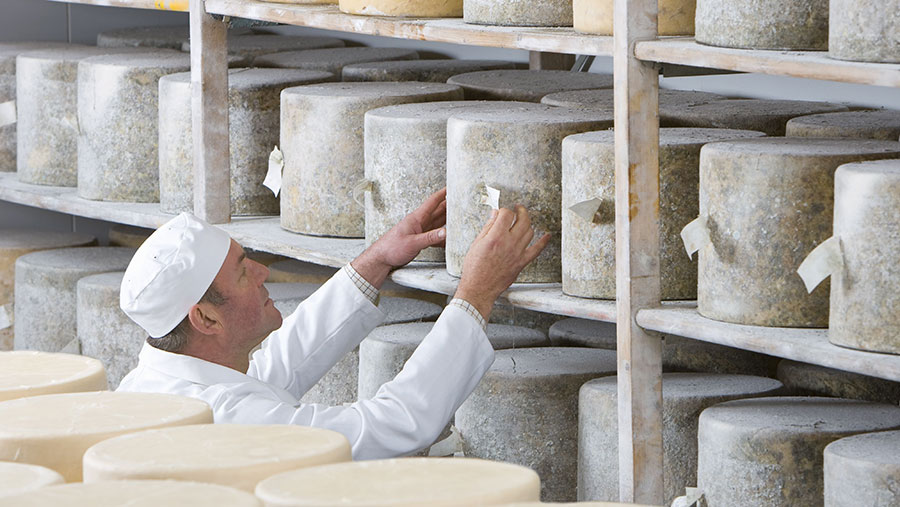What are the prospects for UK dairy trade post Brexit?
 © Juice/REX/Shutterstock
© Juice/REX/Shutterstock
The potential for the UK dairy industry post-Brexit is large, but will require the industry to focus on efficiencies and competitiveness to fully exploit it.
Success will also hinge on what sort of deal the UK gets with the EU, determining what level of tariffs it will be subjected to.
If no deal is achieved and the UK has to revert to a World Trade Organization (WTO) system, tariffs would be as high as 40-50%, making imported dairy products less appealing.
The UK has the world’s second-largest dairy trade deficit, with the vast majority of these imports coming from the EU.
To displace foreign imports – 22,000t of cheddar, 23,000t of butter and 126,000t of butter in 2016, UK farmers and processors would need to ramp up domestic production.
An as yet unreleased AHDB study suggested this WTO scenario could increase UK farmgate milk prices by as much as 12%, although subsidy levels, regulations and currency would also have a large impact on farm profits.
See also: UK must change mindset to succeed with post-EU trade deals
Significant investment in processing facilities and expanding capacity particularly during the spring peak would be necessary for this to be possible.
Rethinking exports
As it stands, 79% of UK cheese exports, and 86% of exports of UK butter and milk powders (skim milk powder and whole milk powder) are shipped to the EU.
The UK will have to displace these exports either domestically or through investing resources into new non-EU markets.
There are “phenomenal” increases in demand for dairy forecast in the Asia-Pacific region, fueled by rapid expansion of the middle class.
Other potentially lucrative markets for British dairy products included Canada, the US, the Middle East as well as in high-income east Asian countries such as Japan, South Korea and Singapore.
To fully exploit these markets the UK need to understand the needs and demands of these consumers that will differ substantially between countries and regions and more consumer insight was needed.
Tough competition
The UK average cost of production is relatively competitive compared with the majority of its western European neighbours, with an average cost of production of about 25p/litre.
However, only the top 5% of UK milk producers are competitive in the global marketplace, against the grass-based, low-cost production systems of the Oceanic region and South America.
It will be difficult for the UK to compete on the commodities market against countries such as New Zealand and Australia, but there are opportunities for some low-value products not in high demand in the UK as well as a number of premium markets, said the report.
With worldwide exports expected to increase 22% by 2026, it is imperative UK farmers drive efficiencies and drill down on their cost of production to maximise competitiveness.
Long-term strategy
Trade deals and consequently export growth will take time to achieve.
Dairy companies need guarantees from the government around post-Brexit arrangements in order to plan, but market access often takes years to put in place.
However, exiting the EU should provide a new momentum for UK exports, generate added significance to exploiting our overseas potential and heighten the focus on global competitiveness, added the report.
What UK industry must do
Understand costs of production
Competing against global producers makes benchmarking and understanding COP essential.
Know our niches
In some sectors, the UK will never be a low-cost producer globally. However, the UK story of quality, food safety, authenticity, provenance and welfare can be used for premium products.
Understand the consumer
Researching and understanding overseas markets and consumers is critical for processed goods as well as carcass and product specifications. All may have knock-on implications for producers.
Maximise value
Getting the most from trade opportunities means developing a broad range of products to maximise the price for each product. This includes products that may be low value in the UK but high value abroad.
Develop company export focus
Focus, time, flexibility and dedication are needed to build market share and reputation. This might mean challenging our mindset, ensuring that we plan for proactive exports rather than take an opportunistic view when “the price is right.”
Look at displacing imported product
Imported product could be significantly more expensive if the UK imposes tariffs to match the EU. There is scope for import displacement to varying degrees, although issues such as carcass balance and seasonality of production would need careful consideration.
Gain access to new markets
Concentrate efforts on market access to ensure continued access to markets post Brexit and also open key markets, particularly for beef and sheep meat.
Time taken and resources required to reach agreement and build market share should not be underestimated and it is important the UK recognises this.
Resourcing export certification and support
Export certification demands are likely to increase substantially as they may be required for EU countries as well.
This is likely to need considerably more resources to prevent the process slowing down. Government resourcing is needed to develop this. This gives scope to further develop electronic systems to support a more efficient certification process.
Advocacy and promotion
Government must continue to promote the UK brand through the Great British Food Unit, ministerial visits and advocacy with a proactive programme of inward visits from the regulatory authorities in key overseas markets.
